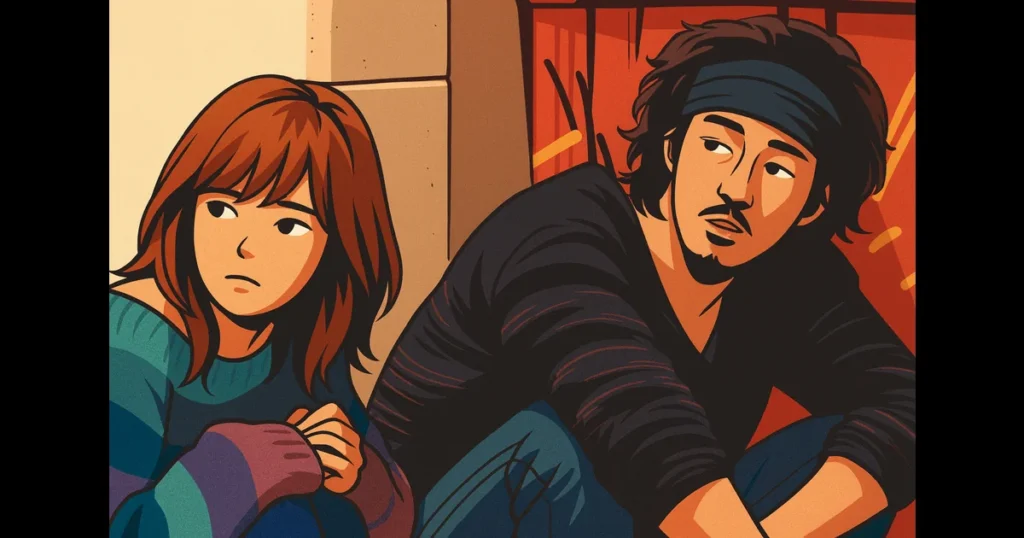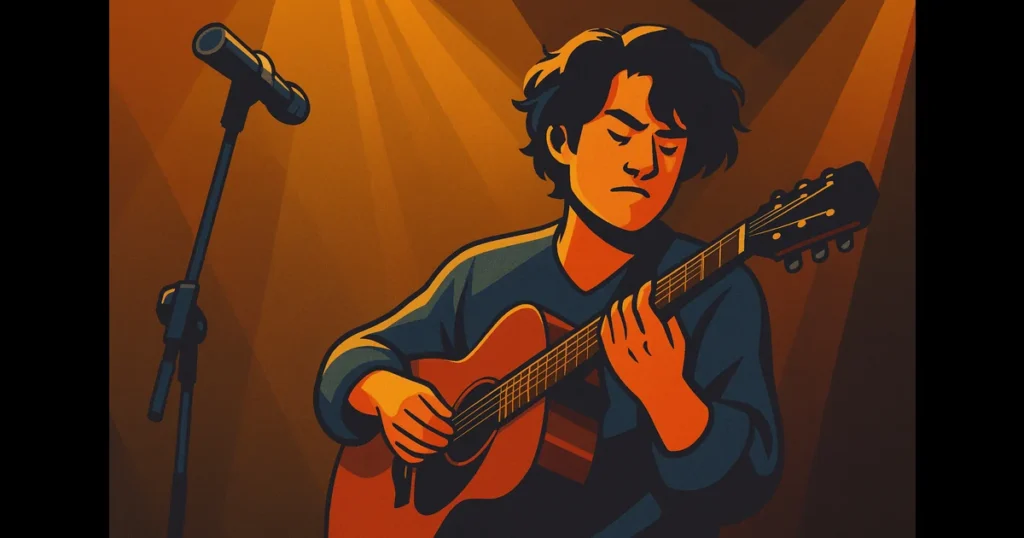[Image Source] AI illustration by DALL·E
TL;DR – Learn Korean emotions through Park Hyo-shin’s “Snow Flower.”
This post uses 박효신’s ballad ‘눈의 꽃’ to explore how Koreans express love, longing, and seasonal comfort through language.You’ll discover conversational phrases inspired by the song, cultural codes like 첫눈의 약속 and the poetic address “그대,” and learn to use gentle, polite endings like “-네요“ for warmth.
Perfect for understanding how music, emotion, and seasonal metaphors intertwine in Korean.
📢 To protect copyright, all lyrics have been rephrased while preserving the original context. I appreciate your understanding.
1. Emotional Snapshot
겨울밤, 오래전 헤어진 두 사람이 다시 마주 섭니다.
차가운 바람 속에서도 손끝이 따뜻하고, 눈발 속에서 약속이 피어납니다.
“다시는 놓지 않을 거야”라는 마음이, 눈송이처럼 조용히 서로를 감싸죠.
그 장면에는 포기하지 않는 사랑과 계절이 건네는 위로가 담겨 있습니다.
On a winter night, two people who once parted ways stand face to face again.
Even in the cold wind, their fingertips feel warm, and in the snow, a promise quietly blooms.
The vow, “I will never let go again,” wraps around them softly, like falling snow.
This moment holds both unwavering love and the comfort that seasons bring.
🎶 Park Hyo-Shin – “Snow Flower”: Music Video
[Source] YouTube, OGAM Entertainment
2. Micro-Expressions from the Lyrics
Not direct quotes from the lyrics, but conversational phrases reimagined from the song’s emotions.
• “봄이 온 줄도 몰랐네요.” – “I didn’t even realize spring had come.”
예문: 어느새 봄이 온 줄도 몰랐네요.
Example: I didn’t notice spring had arrived before I knew it.
• “손을 꼭 잡아요.” – “Hold my hand tight.”
예문: 추우니까 손을 꼭 잡아요.
Example: It’s cold, so hold my hand tight.
• “곁에만 있어도 좋아요.” – “Just being next to you is enough.”
예문: 그냥 곁에만 있어도 좋아요.
Example: Just having you by my side makes me happy.
• “겨울이 다가오네요.” – “Winter is approaching.”
예문: 해가 짧아지고, 겨울이 다가오네요.
Example: The days are shorter now—winter is approaching.
• “울지 말아요.” – “Please don’t cry.”
예문: 괜찮으니까 이제 울지 말아요.
Example: It’s okay now, so please don’t cry.
• “다 해주고 싶어.” – “I want to do everything for you.”
예문: 너를 위해 뭐든 다 해주고 싶어.
Example: I want to do anything for you.
3. Cultural Code & Subtext
– 눈의 약속 (The First Snow Promise): In Korea, there’s a romantic belief that if you see the first snowfall together, you’ll be together forever.
– ‘그대’라는 호칭 (“Geudae” as an Address): Rarely used in daily speech, “그대” is a poetic term conveying both respect and tenderness.
– 계절 은유 (Seasonal Metaphors): Winter is not just a cold season—it’s a symbol of waiting, reunion, and new beginnings.
– Polite endings with warmth: Endings like “-네요” and “-아요/어요” express emotions softly yet politely.
– 손을 잡다 (Holding Hands): More than just physical contact, holding hands signals a commitment to go through life together.
❓ FAQ: About “Snow Flower”
Q1. Who originally sang “Snow Flower”?
A. The song is originally Yuki no Hana by Japanese singer Mika Nakashima. In Korea, it became widely popular after Park Hyo-shin’s remake.
Reddit user comment:
“It’s a Japanese song, Yuki no Hana. Park Hyo-shin did a remake.”
Q2. Why does it become more popular every winter?
A. Because it was the OST for the drama I’m Sorry, I Love You, its emotional and tender mood matches perfectly with the winter season. (en.wikipedia.org)
Q3. How do fans describe their feelings about it?
Reddit users say:
“Whenever I listen to this song, I always end up looping for hours… such a perfect song to listen to during Christmas. Makes you feel all warm and gooey on the inside.”
Many listeners describe it as warm, cozy, and perfect for the winter season.
Q4. What’s the musical charm of the song?
A. The lyrical piano and string arrangement, paired with a warm, emotive vocal delivery, add emotional depth. Critics also praised the original Yuki no Hanat, a piano-string-centered composition. (webnovel.com)
Q5. Which other artists have covered it?
A. In Korea, aside from Park Hyo-shin, Ailee has also performed a Korean cover, as mentioned on Reddit (reddit.com). Yuki no Hana has been covered in multiple languages and regions, including China, Hong Kong, and Vietnam. (en.wikipedia.org)
4. Speak Like the Song
Conversational examples inspired by the song’s mood.
– “계절이 바뀌어도, 너는 그대로네.”
Even as the seasons change, you stay the same.
– “눈처럼 조용히 네 곁에 머물고 싶어.”
I want to stay quietly by your side, like snow.
– “이번에는 절대 놓지 않을 거야.”
This time, I’ll never let go.
– “너의 미소가 내 겨울을 녹였어.”
Your smile melted my winter away.
– “언제까지라도 기다릴게.”
I’ll wait for you, no matter how long it takes.
5. Expression Drill or Quick Quiz
Q1. “-네요” 어미는 어떤 상황에서 자주 쓸까요?
When is the ending “-네요” often used?
A. 말하는 중에 새롭게 깨달았거나, 감탄·공감을 담고 싶을 때.
When you realize something as you speak, or want to express admiration or empathy.
Q2. “첫눈”이 한국 문화에서 상징하는 것은?
What does “첫눈” symbolize in Korean culture?
A. 운명적 만남, 영원한 사랑, 새로운 시작.
A fateful meeting, eternal love, and a new beginning.
Q3. “곁에만 있어도 좋아요”라는 표현은 어떤 감정을 전달하나요?
What feeling does the phrase “곁에만 있어도 좋아요” convey?
A. 조건 없이 함께 있는 것만으로 위로와 행복을 느끼는 마음.
Feeling comfort and happiness simply from being together, with no conditions.
6. Additional Notes on the Song & Artist
– 곡 배경 (Background): A Korean adaptation of the Japanese song “Yuki no Hana,” beloved as a K-Drama OST.
– 박효신의 매력 (Park Hyo-shin’s Charm): Deep, soft, low notes, restrained emotional delivery, and delicate breath control.
– 문화적 유산 (Cultural Legacy): Now considered a seasonal classic that returns every winter.
– 언어 학습 포인트 (Language Learning Points): Seasonal metaphors, polite endings, emotional vocabulary, and poetic word order.
📍 Want More Like This?
Explore more posts in our Korean Emotion & Seasonal Language Series to deepen your understanding of poetic expressions in Korean.


